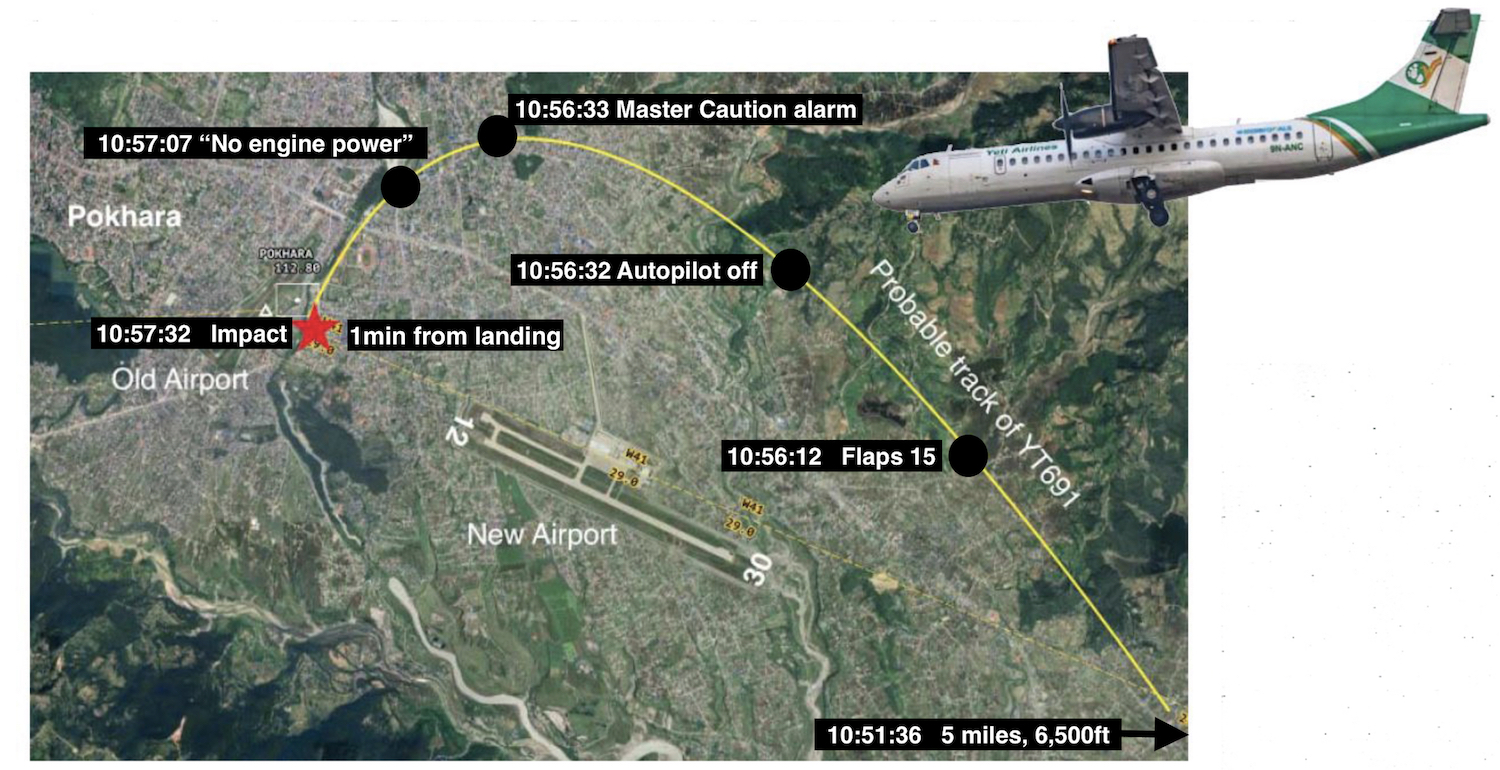Final moments of YT691
Pokhara air crash report says propellers were feathered, but why is still a mystery
A preliminary accident investigation into the crash of flight Yeti 691 in Pokhara on 15 January has confirmed that both the plane’s propellers were feathered just before the plane dived to the ground.
But what remains unanswered is how and why one of the two captains in the cockpit feathered the engines.
With the propeller pitch in a feathered position, the engines do not provide any thrust. The plane was therefore going too slow to maintain lift, stalled and crashed while making the final turn to the runway. (See map)
The ATR-72 212A / 500 turboprop was making its third flight of the day between Kathmandu and Pokhara with the same crew. Captain Kamal KC was a veteran with 22,000 hours of flight experience, while Captain Anju Khatiwada had logged 6,500 hours, and was on a final familiarisation flight to Pokhara’s new international airport that had come into operation only two weeks previously.
There were 68 passengers and four crew on the plane with tail number 9N-ANC which was just about to complete the 26 minute flight from Kathmandu.
The investigation committee included members from CAAN, Transport Safety Investigation Bureau (TSIB) France’s BEA, Transportation Safety Board of Canada, European Aviation Safety Agency (EASA) and the engine manufacturer Pratt & Whitney Canada. They analysed the Cockpit Voice Recorder (CVR) and Flight Data Recorder (FDR) in Singapore.
The report says that further investigation will be needed to determine why the propellers on both engines went into feathered condition.

An ATR cockpit (pictured) has the engine throttle levers, the condition (feather) levers and the flap selection lever in a panel between the two pilots. The feather lever is rarely used in flight, unless there is engine failure, in which case the propeller pitch is changed (‘feathered’) to reduce drag.
One ATR pilot who has seen the preliminary investigation report said it was unthinkable that either captain would deliberately feather both engines on finals.
Khatiwada was sitting on the left (captain’s) seat because she was being certified, and KC was sitting on the right seat. There is speculation that KC was not as familiar sitting on the right side, and may have inadvertently feathered the propellers, mistaking the levers for the flap selection lever.
Even that is unimaginable because the flap selector is white and has an airfoil shape, while the condition levers and the throttle levers are so different to the touch that pilots are supposed to tell them apart even without looking.
On their second flight into Pokhara that Saturday morning, the pilots who had already been cleared for a straight-in approach to runway 30 requested runway 12 from the west. It is not clear why that request was made because the wind was only 3 knots from the south.
From five miles from the threshold of runway 30, the plane broke right and went downwind parallel to the runway. Landing gears were lowered and flaps were down to 15 degrees.
Just before the turn into base leg, the CVR indicates Khatiwada requesting KC for 30 degree flaps. KC immediately acknowledges, saying “Flaps 30, descending”. The crew does the final landing checklist.
However, the FDR did not detect any flap movement, and they were finally lowered 30 second later. However, the FDR showed that at that exact moment, the rotation speed of the propellers dropped to 25% and the torque went down to zero – which means the engines were not providing any thrust.
Neither pilot seemed not to be aware of this until much later, by which time it was too late. Twenty-five second before impact, Khatiwada is heard on the CVR saying twice there is no power from the engines.
Five second later, the thrust levers are pushed to full power. But since the propellers were feathered, they were still not providing any thrust. KC then takes control of the plane, and Khatiwada repeats there is no power from engines.
The stick shaker warns that the plane is stalling while it is flying 311ft above ground level. There is a 200ft radio altimeter voice alert as the plane goes into a banking dive, with the sound of impact on the CVR four second later.
Investigators will now need to figure out who feathered both propellers, and why. Experts said it was impossible for both propellers to feather simultaneously due to a malfunction, and the CVR does not reveal any conversation about a mechanical issue with the engines.

Following is a timeline of flight YT691 based on the Aircraft Accident Investigation Commission of the Ministry of Tourism and Civil Aviation released on 13 February:
10:32:00 Takeoff from Kathmandu
10:51:36 Descent to FL65 (6,500ft) at 5DME (5 miles from airport)
10:56:12 Plane downwind, landing gear lowered, flaps extended to 15o
10:56:27 Autopilot disengaged at 721ft AGL (above ground level)
10:56:32 Pilot Flying (Khatiwada) calls for “Flaps 30”, Pilot Monitoring (KC) confirms “Flaps 30 and descending”
10:56:33 Flight Data Recorder (FDR) does not detect any flap movement, but propeller rotation speed (Np) on both engines decreases to 25%, and Torque (Tq) falls to 0%
10:56:33 Master Caution alarm sounds in cockpit
10:56:50 Radio altimeter sound alert “500” AGL and plane is on a bank angle of 30o
10:56:54 Flaps are finally set to 30o. Khatiwada asks if she should continue the left turn, KC answers in the affirmative. She asks if she should descend, he replies no need but to increase power.
10:57:07 ATC: “Cleared to land runway 12”. Khatiwada says twice that engines are not giving any power. Throttles are then advanced to maximum power.
10:57:18 Khatiwada hands over controls to KC
10:57:20 Khatiwada again repeats that engines are not delivering power
10:57:24 Stick shaker stall warning activated at 311ft AGL
10:57:26 “200” Radio altitude sound alert
10:57:32 Sound of impact on CVR
Full report here.




